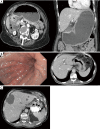Current management of gastric adenocarcinoma: a narrative review
- PMID: 37720442
- PMCID: PMC10502549
- DOI: 10.21037/jgo-22-818
Current management of gastric adenocarcinoma: a narrative review
Abstract
Gastric adenocarcinoma is a leading cause of cancer death worldwide. The management of this aggressive malignancy largely depends on tumor characteristics especially stage. Superficial early-stage gastric cancer can be safely managed by endoscopic resection, though clear negative deep and lateral margins must be obtained. Optimal surgical resection is an essential part of the treatment for locally advanced gastric adenocarcinoma, with perioperative and adjuvant therapies having significant impact on long-term outcomes. Chemoradiation is reserved for patients with suboptimal surgical resection. Recent therapeutic advances have prolonged survival in patients with metastatic gastric adenocarcinoma, include checkpoint inhibitors and biomarker-directed therapy. Targeted therapies in gastric adenocarcinoma include monoclonal antibodies directed against vascular endothelial growth factor (VEGF), vascular endothelial growth factor receptor-2 (VEGFR-2), and human epidermal growth factor receptor 2 (HER2). While anti-VEGF therapies were not found beneficial in the perioperative setting, the effectiveness of HER2 targeted agents in resectable HER2-positive gastric adenocarcinoma is being studied. Microsatellite instability (MSI) varies greatly in patients with gastric adenocarcinoma between 5-20% based on ethnic origin, tumour heterogeneity and staging. The role chemotherapy in the perioperative setting for patients with MSI-high tumors remains controversial while immunotherapy demonstrates promising results in preliminary studies. Immune checkpoint inhibitors in combination with chemotherapy has been shown to improve outcomes in patients with metastatic gastric adenocarcinoma who express programmed cell death 1 ligand 1 (PD-L1) and is now being investigated in the perioperative setting.
Keywords: Gastric adenocarcinoma; gastrectomy; perioperative therapy; systemic therapy.
2023 Journal of Gastrointestinal Oncology. All rights reserved.
Conflict of interest statement
Conflicts of Interest: Both authors have completed the ICMJE uniform disclosure form (available at https://jgo.amegroups.com/article/view/10.21037/jgo-22-818/coif). The series “Current Management of Upper Gastrointestinal Malignancies” was commissioned by the editorial office without any funding or sponsorship. The authors have no other conflicts of interest to declare.
Figures






References
Publication types
LinkOut - more resources
Full Text Sources
Research Materials
Miscellaneous
